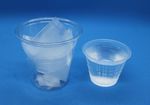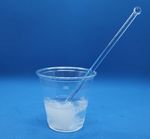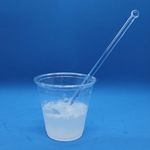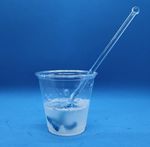Choose and Reuse Compostable Plastics - American ...
←
→
Page content transcription
If your browser does not render page correctly, please read the page content below
Choose and Reuse
Compostable Plastics
ACS Kids Zone activity for use at home or school
Polyvinyl alcohol can be formed into plastic bags that look like other plastics, yet have a
surprising property. This difference makes PVA bags a better choice than other single use
plastics in certain applications. In this two-part activity, students will test four different liquids
on pieces of a PVA bag and then use the bag in a completely different application—to make
slime.
Questions to investigate
• Part 1: Which liquids are PVA friendly?
• Part 2: How can we chemically convert PVA bait bags to slime?
Chemistry concepts
• Substances have characteristic properties, such as solubility.
• Compostable plastics can be broken down by microorganisms to return to the Earth
safely within 90 days in an industrial composter.
• Green chemistry is process of making substances with the properties people want while
minimizing the use of natural resources and the amount of waste created, while
avoiding the production of harmful or toxic products and by-products.
Activity logistics
• Ages: 8-14
• Time: 30 minutes
www.acs.org/kidszone © 2021 American Chemical Society
ACS Kids Zone Choose and Reuse Compostable Plastics, Page 1Be Safe
• Borax powder and borax solution cause skin irritation. Wear disposable gloves and
safety glasses when preparing borax solution, making slime, and playing with slime.
• Store PVA bait bags and slime out of the reach of pets and young children.
General Safety Guidelines
• Work with an adult.
• Read and follow all directions for the activity.
• Read all warning labels.
• Follow safety warnings or precautions written in the Be Safe section of each activity.
• Wear Personal Protective Equipment (PPE), such as goggles, safety glasses, or gloves.
• Tie back long hair, roll up sleeves, and secure loose clothing.
• Be sure to clean up and dispose of materials properly when you are finished with an
activity.
• Wash your hands well before and after each activity.
What you’ll need
• 3 PVA carp fishing bait bags, small 6 cm x 12 cm
• 1 piece of used brown cardboard, such as from an empty cereal box, at least 15 x 20 cm
• Pencil or pen to label areas of the cardboard
• Water
• Rubbing alcohol (isopropyl alcohol), 70%
• Vegetable or mineral oil
• Salt
• Non-toxic washable paint or food coloring
• Borax solution, 4% or borax powder
• Scissors
• Popsicle stick, cocktail stirrer, or spoon
• 4 small cups (medicine cups or portion cups)
• 4 cotton swabs
• ⅛ teaspoon measuring spoon, 0.625 mL
• 1 teaspoon measuring spoon, 5 mL
www.acs.org/kidszone © 2021 American Chemical Society
ACS Kids Zone Choose and Reuse Compostable Plastics, Page 2Part 1
People trying to catch fish, such as carp, that eat from a
lake or river bottom have a problem— getting the bait and
hook to stay together all the way down to the bottom.
People used to fill nylon bags with bait and the hook, but
oftentimes the nylon bag got lost, ending up as trash in the
waterway. PVA bait bags are an alternative to nylon bait
bags that do not leave trash behind. The instructions for
using these bags say that you must use dry bait and a PVA
friendly liquid in the bag. Let’s test different liquids to find
out which are PVA friendly.
Question to investigate
• Which liquids are PVA friendly?
Procedure
Set up your testing area
1. Cut flat piece of cardboard (approximately 15 cm x 20
cm) from a box in your recycle bin. Empty cereal boxes,
cracker boxes, and even shipping boxes work well. Lay
the cardboard on your work surface blank-side-up.
2. Use scissors to cut one bait bag into four similar-sized
pieces. Place each piece in its own separate area of the
cardboard.
3. Write the name of each of the four liquids you plan to
test beneath a piece of PVA.
4. Make a saltwater solution by adding ⅛ teaspoon salt to
5 mL (1 teaspoon) water.
5. Add about 5 mL of each of the remaining the liquids
into separate small cups. Stand each liquid-filled cup in
its labeled area on the cardboard.
6. Place one cotton swab in each cup.
Test the liquids to find which
might be PVA-friendly
7. Use one wet cotton swab
to paint the liquid onto its small piece of PVA. Re-dip the
swab in the liquid to make sure that you cover the entire
surface of the PVA well. When you are finished, place the
wet end of the swab directly onto the piece of PVA.
8. Paint the three remaining liquids on their own piece of
PVA and leave the wet end of each swab on its own piece
of PVA.
www.acs.org/kidszone © 2021 American Chemical Society
ACS Kids Zone Choose and Reuse Compostable Plastics, Page 3What did you observe?
• Which liquid or liquids do not degrade the PVA?
These liquids are considered to be PVA-friendly. If fish like the way these liquids smell,
they could be added to the bait inside the bag to attract curious fish.
• Which liquid or liquids seem to destroy the PVA?
• PVA bait bags are used for fishing in freshwater lakes and rivers, not for ocean fishing.
Why do you think this is the case?
• What do you think happens to the PVA bait bag once it gets to the bottom of a
freshwater lake or river?
Part 2
Unless you plan to go fishing for carp, PVA bait bags could become clutter in
your home or end up as trash. Let’s do some green chemistry and make
these bags into something else that you will want to keep around for a
while—slime. Green chemistry is a process of doing chemistry that
minimizes the use or generation of harmful substances. Minimizing waste,
reducing demand on natural resources, and conserving energy are all part of
green chemistry. We can practicing green chemistry when learning science
by choosing activities that require small amounts of non-toxic substances,
reuse materials, and minimize the amount that we throw away.
Question to investigate
• How can we chemically convert PVA bait bags to slime?
Procedure
Prepare your solutions
1. Crumple up two small PVA bait bags (6 cm x 12 cm) and
place them in a small bowl or cup.
2. Use the medicine cup containing water to measure 30 mL
of water. Pour this on top of the crumpled bait bags.
3. If you have pre-made borax solution, use it. If not, make
your own borax solution by adding ⅛ teaspoon borax to 10
mL of water. Stir until most of the borax dissolves.
4. Use a Popsicle stick, stirrer, or spoon
to mix the PVA bags into the water.
Stir until the PVA dissolves.
Make slime
5. Add a little food coloring or non-toxic washable paint to either the
PVA solution or borax solution. Stir until the color dissolves.
6. As one person stirs the PVA solution, have another person slowly
add 1 teaspoon of borax solution.
www.acs.org/kidszone © 2021 American Chemical Society
ACS Kids Zone Choose and Reuse Compostable Plastics, Page 4What did you observe? • How did the PVA bags change after you poured water on them? • How does PVA solution change when adding borax solution? • How is this slime like other types of slime you have made? How is it different? How does it work? PVA stands for polyvinyl alcohol. It is certified compostable meaning that it will break down to become nutrients for soil within 180 days in an industrial composter. PVA breaks down into non-toxic substances quicker than most compostable plastics. It dissolves, biodegrades, and does not harm fresh water ecosystems. PVA molecules are very attracted to water molecules. The attractions to water molecules cause the PVA molecules in the solid bag to separate from one another and dissolve in water. PVA-friendly liquids are either oil-based and do not mix with water or they keep their water molecules close, so that these water molecules are not available to dissolve the PVA. Adding an oil-based PVA friendly liquid to dry pellets of carp bait helps attract fish. As the PVA dissolves, the added liquid begins to float up to the surface, creating a long scent-trail between the river bottom and the water’s surface. This scent-filled column captures the attention of curious carp. As they explore and search for the source of the scent, they swim down to the river bottom. By that time, the PVA bag has dissolved, leaving a neat pile of bait and hidden hook! Where’s the chemistry? PVA has many uses. It is used to make laundry bags for hospitals to control the spread of infectious disease in used sheets, blankets, and hospital gowns. Once loaded up with dirty clothes, workers put the filled bag of dirty laundry bag into a large washing machine. The hot water dissolves the bag quickly and the laundry gets clean. PVA protects workers by making it so that they do not have to touch dirty laundry as they load it into the washing machine! PVA is a common ingredient in peel-off facial masks, hair gel, glue, paint, and detergent pods. If you look in the ingredient list of these products, you will likely find the words, polyvinyl alcohol. School glue, like the kind commonly used to make slime, contains a related polymer called polyvinyl acetate. Both polyvinyl acetate and polyvinyl alcohol bond with sodium tetraborate (Borax) forming a flexible net-like structure that holds water molecules in place. This is why PVA bait bags, which dissolve quickly in cold water, can be used to make slime. www.acs.org/kidszone © 2021 American Chemical Society ACS Kids Zone Choose and Reuse Compostable Plastics, Page 5
Clean up
• If possible, reuse the cardboard again. When you are done using it, place the cardboard
in your recycle bin.
• Place the cotton swabs and small testing pieces of PVA in the trash.
• Wash and reuse the small cups or bowls.
• Store your slime in a zip-closing plastic bag or reusable container that is not used for
food.
References
• Bait bags for carp fishing
https://www.youtube.com/watch?v=88tXbpQROKE
https://www.carpology.net/article/bait/how-to-get-more-out-of-pva-bags/
https://www.carpology.net/article/bait/attraction-filled-pellet-bags/
• Carp image
Hagerty, Ryan/USFWS, Public domain, via Wikimedia Commons
https://upload.wikimedia.org/wikipedia/commons/1/14/Grass_carp_portrait.jpg
• PVA laundry bags
https://www.polyemat.com/how-to-use-water-soluble-laundry-bags-properly/
• PVA laundry bag slime
https://www.youtube.com/watch?v=8khydik_KRI
• Polyvinyl alcohol, CAS Registry number 9002-89-5
https://commonchemistry.cas.org/detail?cas_rn=9002-89-5&search=9002895
• SDS for polyvinyl alcohol solution
https://www.flinnsci.com/sds_608.1-polyvinyl-alcohol-solution/sds_608.1/
• Review of the oral toxicity of polyvinyl alcohol (PVA)
https://pubmed.ncbi.nlm.nih.gov/12504164/
www.acs.org/kidszone © 2021 American Chemical Society
ACS Kids Zone Choose and Reuse Compostable Plastics, Page 6You can also read



























































